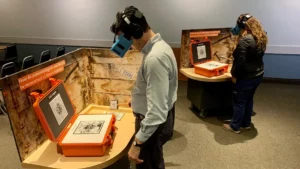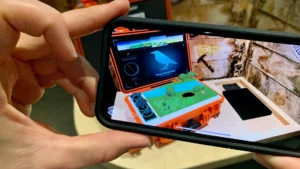Background
TAR AR was a research project that explored how different designs for Augmented Reality (AR) experiences affected learning outcomes. The project was a collaboration between ICT’s Learning Sciences team, Mixed-Reality (MxR) Lab, Rossier School of Education, Natural History Museum of Los Angeles County and La Brea Tar Pits, an active paleontological dig site, where the research was conducted. The project used Augmented Reality to enable visitors to travel back in time as a junior Paleontologist, with the ability to access places, flora and fauna that no longer exist, to engage in the scientific method and help to solve some mysteries on the museum grounds.
Objectives
The project had two major goals:
- Develop scientifically accurate assets for AR experiences, leading users through a virtual narrative, to enhance place-based science learning.
- Conduct systematic usability and comparison studies around visual immersion and interactivity in augmented reality (AR), to identify how it affects visitors’ engagement and understanding of science.
Two “Tar AR” experiences were developed and studied:
- Pit 91 Experience: A tabletop AR experience located at Pit 91, based on fossils found in that area, where Learners could “dig” up fossils to reconstruct a simulated environment. Each fossil cycle supported structured hypothesis testing and revision about the climate at La Brea during the Ice Age.
- Field Experience: A life-sized (animals and plants to scale) AR experience located within the La Brea Tar Pits park which took visitors “back in time” overlaying a narrative Ice Age scene onto the surrounding area.
Results
Visitors showed highly significant learning gains across all conditions, with nearly all major content areas well understood (e.g. from 60% to 84% after the 10-minute Field Experience). Nearly all visitors also overcame common misconceptions, such as that the Ice Age in Los Angeles was snowy (it was only a bit colder and wetter) or that only large animals became stuck in the pits. Results from the Field Experience also showed that visitors with AR produced better explanations of scientific content and processes (e.g. over 44% longer explanations on the entrapment process after using an interactive AR headset). Across both the Pit 91 and Field Experience, handheld AR using smartphones produced comparable or better learning outcomes than low-cost Headsets which embed phones.
Engagement was also high, with the vast majority of visitors reporting both high interest in science at La Brea (96%), strong emotional interest and curiosity (88%), and behavioral intentions to learn more (91%). Visitors using headsets indicated stronger affective engagement on surveys when in the larger immersive Field experience, but these emotions were mixed: while their positive sense of Surprise was slightly higher (+.20 on a 5-pt scale), they also reported increased negative emotions such as Frustration (+.51)
The results of this work indicate that when designing AR experiences:
- Both small-scale and life-sized AR can produce strongly significant learning gains and reduce misconception using only smartphone hardware;
- Phone-based AR (without headsets) offers comparable outcomes, with fewer logistical hurdles; and
- AR headsets may produce greater emotional engagement, particularly in larger-scale/immersive environments such as outdoor settings, but may have trade offs with negative emotions that may affect certain populations or contexts (e.g., unfamiliarity or discomfort with headsets, heat/humidity).
Finally, this work pioneered an approach to rigorously document and publish the process for developing the 3D paleoart (virtual plants and animals from the Ice Age). This should influence future designs for scientific art, because artistic depictions are often a primary way that the general public learns about prehistoric animals and scenes.
Next Steps
AR research and outreach is ongoing in collaboration with La Brea Tar Pits. A set of AR filters were released, allowing a phone to overlay an animal for limited interactions and “selfies.” Filters available through La Brea Tar Pits allow learners to view and interact with the 13 extinct species of Pleistocene animals on any smartphone, at any time via Snapchat, Instagram, and using app-less AR from Sketchfab. Signs on-site at La Brea Tar Pits also provide the AR filters with fun facts about each of these animals in Hancock Park for visitor use. These filters have been accessed over 500,000 times in the past twelve months since their release. Coordination is also ongoing to distribute the larger AR experiences through on-site signs. Based on this work, we are also pursuing further collaborative research to investigate best-practices to encourage conversations and social interactions when learning in AR. In this way, we hope to leverage AR technology to encourage greater in-person connections and learning together.
Published academic research papers are available here. For more information Contact Us


